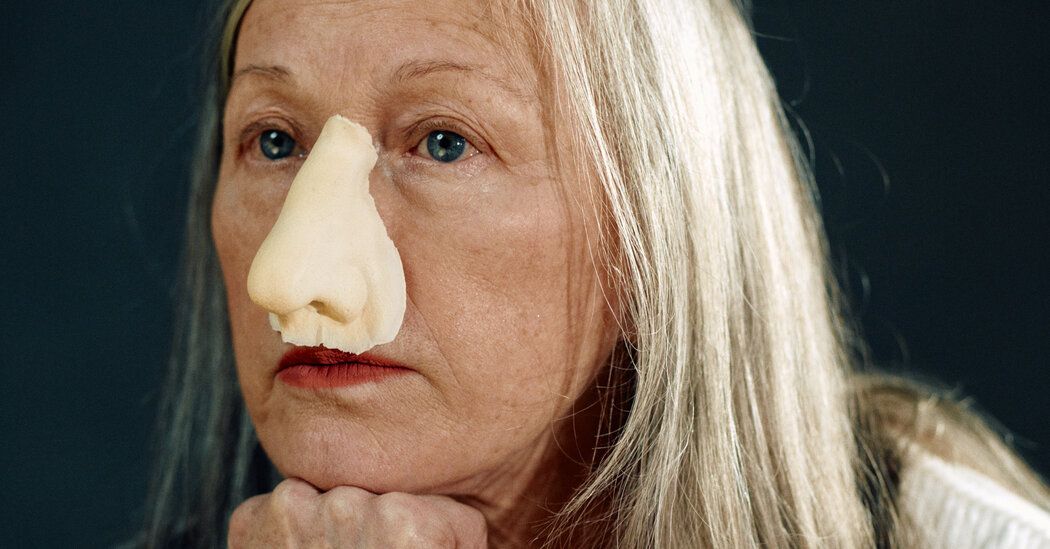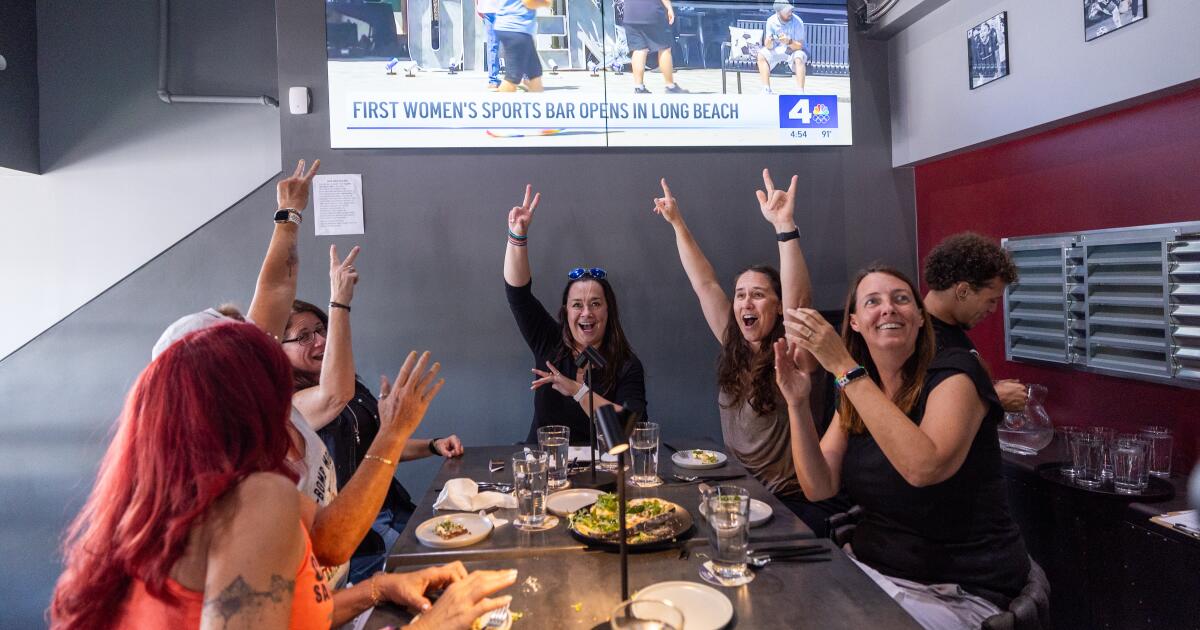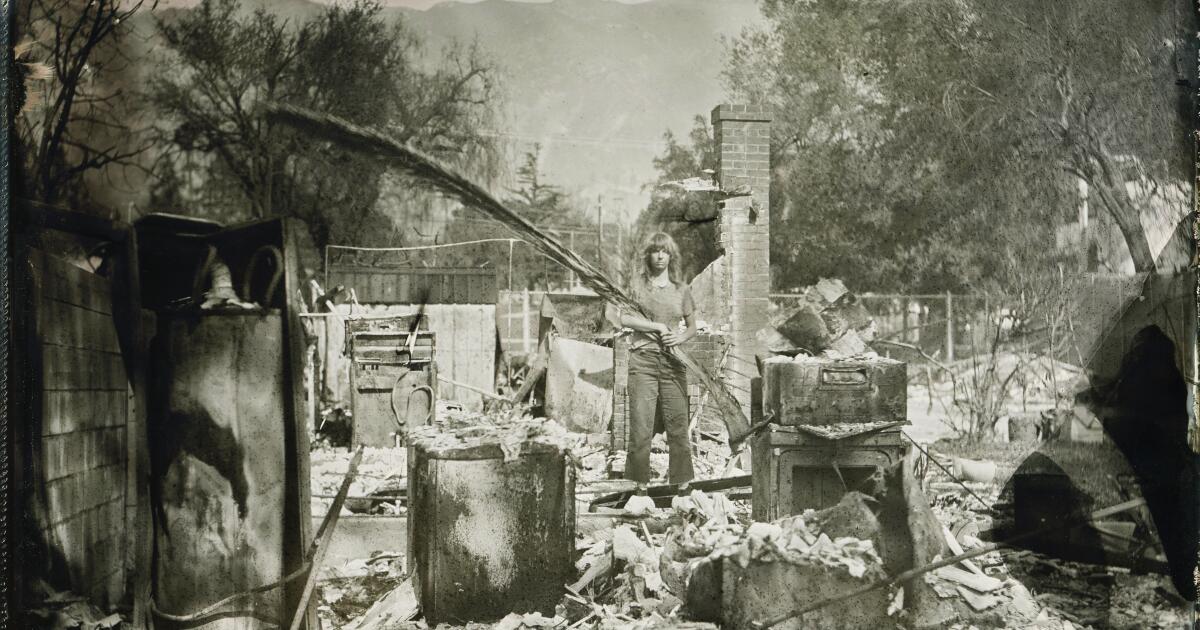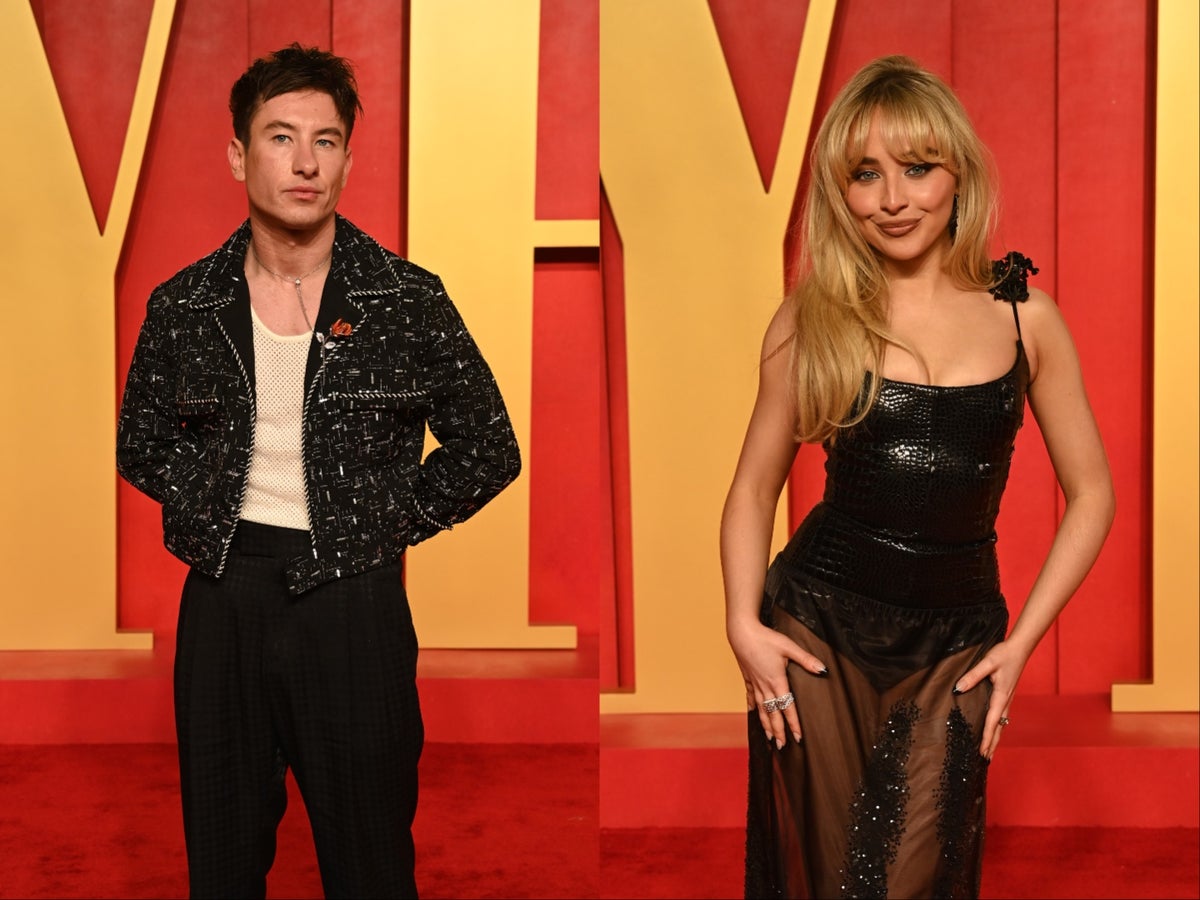The facial features in Cindy Sherman's hyper-energetic new photographic portraits glide madly. Her eyes turn in different directions, clamorously competing for attention. Noses and mouths get involved in a pitched conflict. The electrifying images, now on view at Hauser and Wirth's SoHo gallery, are primarily black and white, but there are areas of vivid color.
By stitching one fragment of skin, makeup, hair, and headdress against another, Sherman dispenses with Photoshop's ability to soften edges. Instead, he creates a sense of instability by folding photographic pinches and stuffing them right into the wrinkles of his aging subjects. Finding physical comedy in the women's efforts to hide the effects of time is the least of her worries. There is also the dark humor she brings when considering the credibility of the photograph. And the touch of pathos she adds to both.
When Sherman emerged meteorically in the late 1970s, it was with an extended series of black-and-white photographs she took of herself. They should not be confused with self-portraits. In each, Sherman, newly arrived in New York City from Buffalo, was made up and dressed to suggest that she was the (fictional) star of an (imaginary) noir film. Her timing was perfect. The feminist art of the late '60s and early '70s, which stripped the body and examined the soul, had given way to more conceptually based work.
Femininity was understood to be a cultural construct, a masquerade, and Sherman's photographs were considered exemplary of this turn. In the decades that followed, quite independently of the politics around her, Sherman continued to display his face and her body in extravagant costumes ranging from an Italian Renaissance Madonna to an American clown.
For all its discontinuities, the current work (all untitled) seems newly grounded. It arose, Sherman told me, from a creative crisis. In a conversation in the gallery, she was warm and open and, as we settled in, she admitted: “I was going through a real creative block during Covid.” She had committed to the exhibition in New York and an earlier one in Zurich and, she says, “she had no idea what she was going to do.” While she “played” with a set of photographs from 2010 (in color, as usual), she decided to convert them to black and white. She clicked.
The smaller works in the exhibition (dated 2010/2023) are assembled from 14 years of photographs. The larger ones, which expand the series, are all new, made with a different camera that allowed for higher resolutions, making the environment harsher or clearer “simply by adjusting the contrast,” he said.
They look less like “something you would have just photographed with your phone and put on Instagram.”
Sherman and I met on a frigid, slushy day, and she was fashionably dressed to brave the weather in a big bright orange sweater, light-colored baggy pants, and white high-top sneakers with chunky, bouncy soles. On the contrary, her face, without makeup, is pretty and timeless, and her eyes are innocently blue. Only her shoulder-length hair, once blonde and now gray, suggests she is turning 70. She is a proverbial blank slate and, despite all her fame, she is rarely recognized on the street.
Sherman sees the disjunctions in the faces of his new work almost as an exercise in cubism. “You're looking at the face and imagining it moving through space,” he explained. To maximize that effect, the black and white segments are stitched together digitally; the colored pieces are glued on top.
The photographs induce a surprisingly urgent search for something, anything, that seems purely real: perhaps a patch of skin up to the hairline, just below the edge of a wig, or around the mouth. Of course, it's all flesh, some of it so enlarged that the pores open and the pancake makeup shines like wet cement. The various directions in which features point, and in particular misaligned eyes, invoke a very specific type of human desire: we seem to want to know quite insistently where to direct our attention when looking at another person. The hunt can be almost embarrassingly intense.
And for her, manipulating features is pure play, with “all my favorite eyes and noses, wigs and fabrics.” There is certainly pleasure in this work, and also some silliness, both of which are in short supply these days. But the question inevitably arises: do we laugh at older women or at them?
To put the question another way, how personal are these photos? “I feel like I'm preparing for it,” Sherman said of aging. “This is what you're going to get, so get used to it. He's coming. It is floating over all our heads.”
True enough; and I am pleased to report that there is no resemblance between these mosaic witches and the artist. However, this work seems clearly intended to recognize the real-life consequences of living for a time beyond youth. In recent years there has been increasing attention paid to older female artists, a trend that Sherman confirms with reservations. “I think things are changing, little by little,” she says. “It's definitely better than 40 years ago for women and artists of color, but we're still not where we should be.”
In a short 2007 essay on the late work of sculptor Louise Bourgeois, feminist art historian Linda Nochlin noted that an artist's “late style” is supposed to involve a “luminous softening of boundaries,” as in water lilies. of Monet or in the dark paintings of Rembrandt. Pictures. But Nochlin noted a potent variant, as in the case of Bourgeois, of a late work that is uncompromising, difficult, and full of “unresolved contradictions.” I suggested to Sherman that she was in the latter camp and reluctantly obtained another agreement.
She admitted that one of the early works, of crime scenes and nauseating expanses of moldy food (she calls them “disaster” images), produced in the mid-1980s, was meant to be a challenge.
“I felt like I didn't want to be the flavor of the month,” he recalls of his new success, so he challenged collectors to “put vomit on the couch.” But she resisted the idea that her most recent series of “socialite” photographs from 2008, which feature perversely sharp portraits of wealthy older women, were aimed at criticizing the collecting class.
Sherman explains that he didn't necessarily think of socialites as art collectors. “I definitely saw them as rich people, a certain type of rich people,” he says, but adds that he had sympathy for them, not contempt.
“I think I identified with a kind of sadness” behind its luxurious houses and gardens. “They are putting up a good front to hide a terrible marriage or children who don't love them, or God knows what they had to sacrifice to have that fur coat. “I’m seeing what it has cost them and I hope that is reflected in the picture,” he said. And she feels a personal connection. “In terms of growing older like them,” she says, “I feel like I've become more like them in real life, in some sad and funny ways.”
While he admits there is an element of defiance in the current work – “I'm not going to approach this aging process quietly or happily,” he said – humor certainly matters in Sherman's current portraits in a way that it doesn't. in, say, the late Rembrandt. Of a photograph in which a face peeks through a boxwood hedge, he remarked: “That's one of the silliest.” Another, featuring a comically bemused subject with clumsily applied lipstick and eyebrow liner, his head and shoulders wrapped in enormous terry towels, Sherman considers “the only one that almost seems too narrative. He maybe he just got out of the shower or goes to a spa.” It's also the only one, he thinks, that could reasonably be compared to the film's first stills.
As she has from the beginning, Sherman works alone in her TriBeCa studio, with cameras, a mirror and an ocean of props: wigs, costumes, fabrics, plastic foliage, prosthetic noses, objects collected 30 years ago in flea markets that they do not exist. exist.
The New York that offered cheap treasures to urban scavengers is no more, and Sherman, who still lives and works primarily in the city, has spent more time since Covid in East Hampton, where he has a garden and chickens, and a studio in a small converted barn that you would like to expand. The enthusiastic cosmopolitan naivety of the still images is only visible in the rearview mirror.
In a 2018 talk (which can be viewed on YouTube), art historian Hal Foster, who defended Sherman from the beginning, returned to the theme of the masquerade and said that his work represents the condition of being seen, specifically by the male gaze. The undoubtedly illuminating and influential argument (it's really useful to see his work that way) was also promoted in the '80s by critics Douglas Crimp and Craig Owens; Looking back, it seems fair to say that he was shaped to a surprising degree by male observers.
When I suggested that to Sherman, she laughed. The frame never had much appeal to her, and it has less of it now, she said, although she supposed it might speak to younger artists trying to find their place in the world. “I just feel like at this point, as we get older, we become a little more invisible,” she said. “So maybe there's not much to look at.”
But Sherman keeps a cautious eye on the commercial media that were long considered the primary instruments of men's objectification of women, from Hollywood movies to print publications and fashion magazines in particular. She still prefers to read on paper and finds fashion design and its representation fertile territory. Even really terrible ads sometimes interest her, which helps her hone a seemingly impossible-to-improve idea for how to build an eye-catching image.
For more positive influence, she cites photographer Kristin-Lee Moolman and stylist Ib Kamara, whom she follows on Instagram. He has also been inspired by costume designer Machine Dazzle, imp_kid and others.
When I said that Hal Foster thinks the selfie world owes a lot to Sherman, he bristled at the idea. “I don't think of my work as selfies at all. “A lot of people were taking photos before me,” he protested. But she does use Instagram creatively. “When I have free time (for example, in a taxi), I play with various apps,” she said. “I started with apps that people use to take selfies and then found ways to subvert them. That's where these strange avatars come from,” she said, referring to her popular posts.
Sherman has also used artificial intelligence programs in her publications, but like other artists, she worries about being scammed by AI, saying, “I tried to use it to see if I could replicate something in the style of Cindy Sherman. “The result, she happily reports, was “pathetic.” But she admitted that “that doesn't mean it won't happen.”
The conversation I had with Sherman was recorded on my smartphone and transcribed (almost instantly) by an artificial intelligence program; It is not impossible that some credible but digitally hallucinated words, using algorithms that we did not control, have slipped into those we pronounce. Sherman has been the sibyl of such proliferating confusions, playing with the integrity of representation and the limits of identity for more than four decades.
There are currently over 600 Sherman conversion models to choose from. Each one asks that we avoid confusing the dancer with the dance. The newer ones confirm that he continues to run as fast as he can.
Cindy Sherman
Through March 16, Hauser & Wirth, 134 Wooster Street, SoHo, 212-542-5660; hauserwirth.com.












